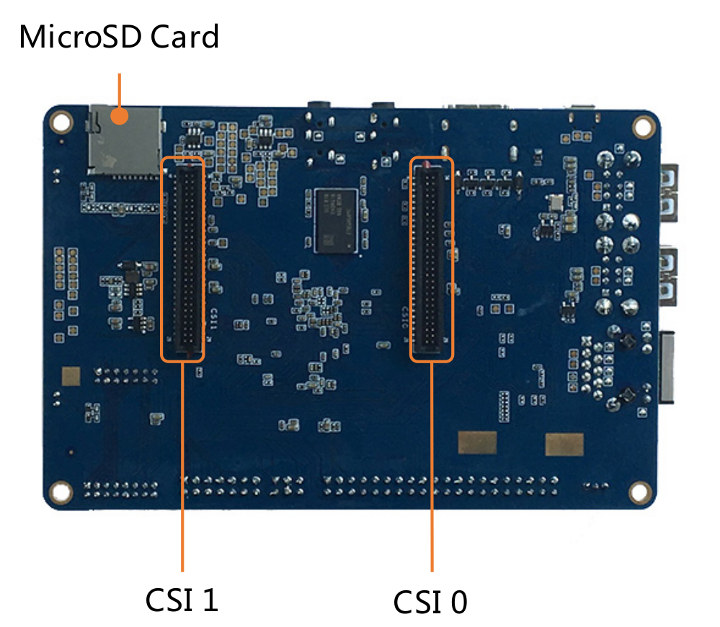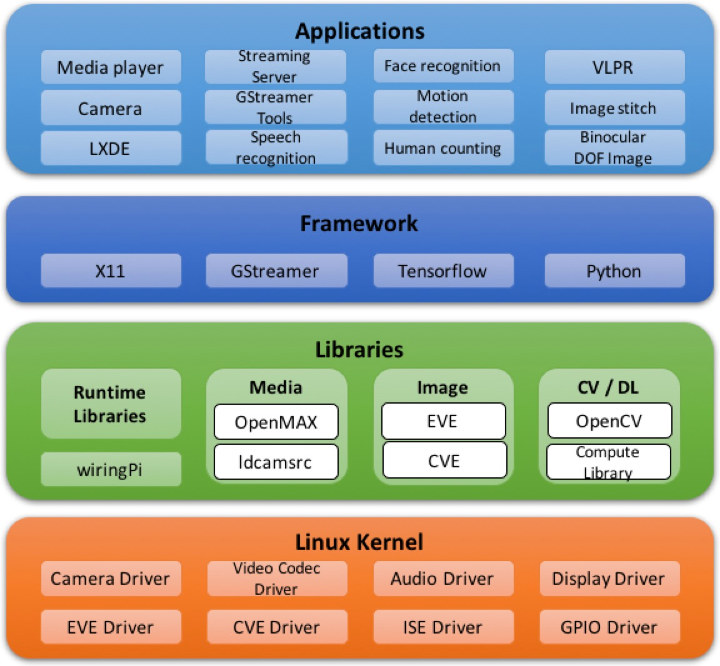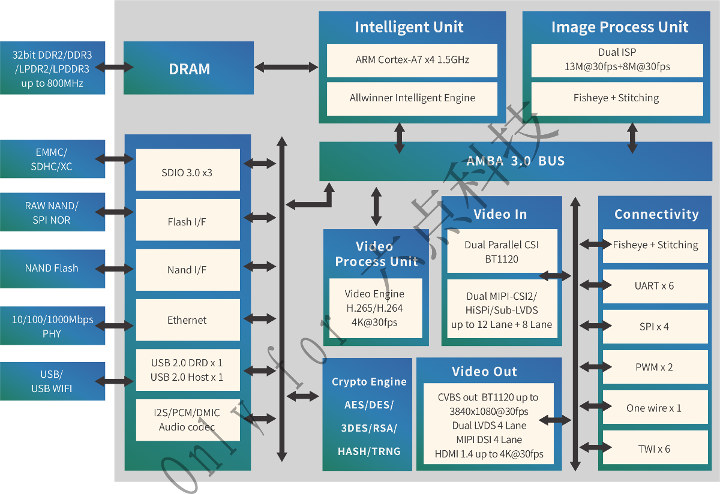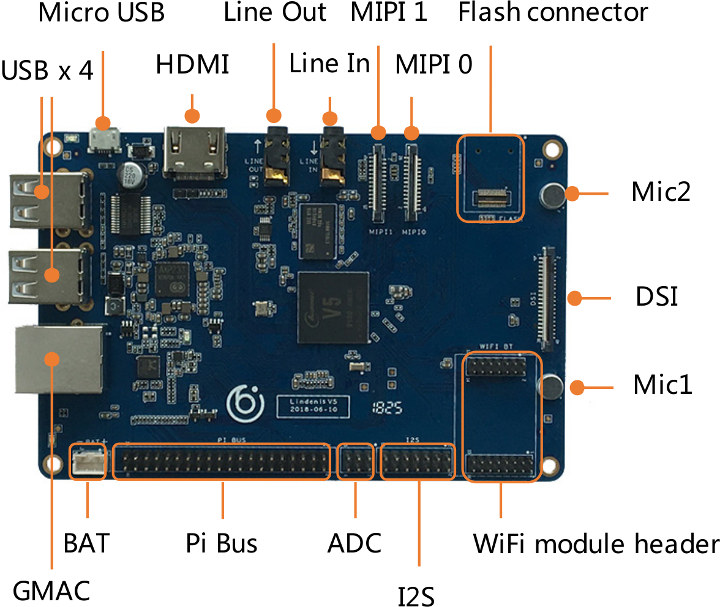Allwinner V5 V100 is a new quad core Cortex A7 processor targeting 4K 30 fps (Linux) cameras, and integrating AIE intelligent analytic acceleration engine handling motion detection, perimeter defense video diagnosis, and face detection.
Usually, it’s pretty hard to get a development board based on a new processor, but Lindenis V5 single board computer based on the processor is already available in China, and comes with 1 to 2GB RAM, HDMI 1.4 and MIPI DSI video outputs, dual MIPI CSI video inputs, Gigabit Ethernet and more.
Lindevis V5 SBC specifications:
- SoC – Allwinner V5
- Quad-core Arm Cortex-A7 processor @ up to 1,512 MHz with NEON, VFPv4 FPU
- 4K @ 30 fps H.265/H.264 encoder and decoder
- Dual ISP 13M@30fps + 8M@30fps
- AIE (AI Engine) Architecture – Built-in with intelligent analytics acceleration engine with support for motion detection, perimeter defense, video diagnosis, face detection, flow statistics. Supports binocular depth map.
- System Memory – 1 or 2GB RAM
- Storage – Micro SD card (SDHC/SDXC) up to 256GB, eMMC flash module socket
- Video Output / Display Interface
- HDMI 1.4 type A up to 4K @ 30fps
- 4-lane MIPI-DSI up to 1080p
- Video Input – 2x MIPI-CSI2 camera interfaces (1.27mm pitch), 4 lanes per channel
- Audio – 3.5mm Line in and Line out jacks, 2x microphones
- Connectivity – Gigabit Ethernet, optional WiFi + Bluetooth SDIO 3.0/UART module via dual header
- USB – 4x USB 2.0 host ports
- Expansion Ports
- 2x 20-pin “PI BUS” 2.54mm pitch GPIO Header, compatible with Raspberry Pi B+ J8 GPIO Header
- 2x 3-pin ADC Header (2.54mm pitch)
- 2x 7-pins I2S Header (2.54mm pitch)
- Power Supply
- 5V via micro USB port
- 3.7V Li-Ion batter via VBAT battery connector (2.0mm pitch)
- Dimensions – 130mm x 85mm
 The AIE appears to be further divided into two parts:
The AIE appears to be further divided into two parts:
- EVE – Embedded Vision Engine
- Designed for rigid target (such as human face, head, shoulders and etc.) detection
- 360p detection speed is more that 30fps
- Minimum single-image detection of 64×64 pixel
- Maximum 4K resolution input and internal scaling, supporting interesting region detection
- CVE – Computer Vision Engine
- Designed for moving target (car, pedestrian, animal and etc.) detection
- D1 resolution is up to 10fps
- Minimum 8×8 pixel for small object detection
- Maximum image of 720p
- Supports various intelligent analysis applications
- Perimeter intruder detection supports maximum warning region numbers of 32
- Perimeter intruder detection can classify people and car by combining calibration algorithm
- Warning line detection supports maximum trip wires of 32-line
- Warning line detection supports single/dual direction detection

The company provides support for Linbian OS based on Debian 9 and Linux 4.4, and that includes OpenCV, a Compute Library, support for Tensorflow and
GStreamer with hardware acceleration among others libraries and frameworks as shown above. You’ll find a fair amount of information in the Wiki, including the some hardware files (PDF) like schematics and pinout diagrams, as well as getting started guide for the SDK, and datasheets for all main components including Allwinner V5 processor.

Lindenis Tech. Ltd. website shows icons for both Taobao and Aliexpress, so that probably means eventually Lindenis V5 SBC should be available worldwide, but right now the board is only to be found on Taobao where it is sold for 499 CNY, or about $74 US. You’ll also find accessories over there such as the wireless module (AP6255 – 802.11ac WiFi, Bluetooth 4.2) and an 8MP 4K MIPI CSI camera module.

Jean-Luc started CNX Software in 2010 as a part-time endeavor, before quitting his job as a software engineering manager, and starting to write daily news, and reviews full time later in 2011.
Support CNX Software! Donate via cryptocurrencies, become a Patron on Patreon, or purchase goods on Amazon or Aliexpress






And yet another Allwinner no one ever has heard of (at least googling for sun8iw12p1 results in zero hits). Seems this is really a 1.5Ghz chip: https://github.com/lindenis-org/kernel/blob/v5-official/arch/arm/boot/dts/sun8iw12p1.dtsi
This is very new chip, the “SDK” linux with binary blobs is sold for $500 I’m waiting to see what software this board will come with. This is the first Allwinner chip with H265 hardware encoding. John Smirl knows more (I guess he will post here) as he deals with cameras and video apps.
I was wrong above (most probably searched for the wrong term). Parts of sun8iw12p1 stuff were already released with other BSPs, e.g. DRAM initialization: https://github.com/Allwinner-Homlet/H3-BSP4.4-bootloader/tree/master/uboot_2014_sunxi_spl/sunxi_spl/dram/sun8iw12p1
Yep, looking forward to Jon’s comments but based on his time zone we’ll have to wait a few more hours 🙂
There is reference also to a V3 board?
http://wiki.lindeni.org/index.php/SDK_Download_and_Build
All available platforms:
0. eagle(Allwinner-V5,sun8iw12p1,arm)
1. petrel(Allwinner-H3,sun8iw7p1,arm)
2. cuckoo(Allwinner-V3,sun8iw8p1,arm)
This is just standard output of this specific Allwinner BSP build script and those birds are SoC names not boards 🙂
Kernel source is here:
https://github.com/lindenis-org/kernel
Charbax mentioned Allwinner V5 and V3 before in action cameras
http://armdevices.net/2018/04/19/allwinner-v5-real-4k30-action-camera-and-security-smart-camera-chipset/
Here what I know about the V5. The chip was announced about 18 months ago. It has been shipping during that time in low volume, I suspect production issues. Apparently now it is more easily available. The only price quote I have heard is $15. I suspect that is higher than the final price since it was from the limited availability period. Search for “allwinner v5 dv100” and you’ll find a V5 based camera that has been out for a year now.
The focus of camera chips is on the coprocessors, not the main CPU. This chip has quad Cortex-A7 but as a comparison the equivalent HiSilicon chips have ARM11 cores. These chips have monster coprocessors compared to other Allwinner chips. If we had a die shot I suspect the A7 cores would be significantly smaller than the coprocessors.
First up is is the dual 4K MIPI CSI and the dual ISP 13M@30fps + 8M@30fps. That’s a pair of full speed 4K cameras. A pair of cameras can do binocular vision or 360 degree spherical VR. Note the ISP can do stitching and spherical correction in realtime. Binocular vision means depth perception without expensive TOF hardware.
Next is the AI subsystem which is totally new. I have not worked with it yet, but some obvious applications are object recognition for robots, or differentiating leaves blowing from humans moving in a security camera.
Now the encoding pipeline. 4K @ 30 fps H.265/H.264 encoder and decoder. Again completely new hardware with the h.265 encoding support. h.265 is much harder to encode than it is to decode. The chip has the h.265 decoder in it so that a camera can view stored footage from an SD Card.
Finally Ethernet and wifi are also both coprocessors.
So you can see that all of the heavy lifting that this chip is designed for is done by dedicated coprocessors rather than the main CPU. This is pretty much the camera pipeline from current flagship cellphone CPUs selling for $60-100. But those cell CPUs add on a GPU and a heftier main CPU which is why they cost more.
One flaw – it is missing ARM Trustzone. It has a tiny OTP that is not large enough to hold SSL keys. I’d like to have secure boot on security camera hardware.
I would like to share some information. V5 is started to design in early 2016. The chip has tow packages, V100 and DV100. V100 is designed for high-level camera solution.DV100 is designed for SDV. SDV enter mass production in April 2018. The chip has a long development cycle, mainly because the chip has many new features and performance improvements to previous chip – V3. Regarding price, now the price of high-volume purchases is less that $10.
As I understand it, V5 as second generation for smart encoding and intelligent video processing, which represents the progress and determination of Allwinner in this industry. In the near future, more competitive chip will be coming to flourish our line of products.
csjamesdeng, what is this reference to the V3? Is there a newer V3 SDK? I would truly like to get rid of Camdroid. Also, are you planning an V3/S3 boards?
All available platforms:
0. eagle(Allwinner-V5,sun8iw12p1,arm)
1. petrel(Allwinner-H3,sun8iw7p1,arm)
2. cuckoo(Allwinner-V3,sun8iw8p1,arm)
No new version from Allwinner anymore, I guess. I planning to develop a new SDK for V3/S3 and a DVB (design verification board). Kernel uses official 3.4 version, maybe upgrade to mainline in the near future. Rootfs uses buildroot. Toolchain uses Linaro version. Will refactor the userspace API of VE, display, etc. . Planned for release in November. Looking forward to your suggestion and advice.
Are the api for EVE and CVE documented anywhere? The datasheet has little information on the capabilities.
Also when will the board be available on aliexpress?
Manuals are here….
http://files.lindeni.org/lindenis-v5/documents/soft_design/MPP/
Hi Jasbir, the board available on aliexpress now, https://www.aliexpress.com/store/4504082
How can you get around the closed source libisp that is in the 3.4 kernel? If you could get Allwinner to release source for that it would be possible to fully support V3 in mainline. Without that source everyone is stuck with 3.4. 3.4 is a problem for us because it predates Bluetooth LE.
V3 is actually a quite good chip for the price. But the Camdroid SDK is killing it for use in broader applications. Maybe Allwinner can breathe some new life into this chip by releasing the libisp source and getting it into mainline.
Regarding the source, We’ll figure it out。
Okay, Jon Smirl, you have had 5 months to dev. What is your current appraisal of this rig?
This is a very good 4K camera implementation. We are not using the binocular depth vision function, but other people appear to be using it without problems. The software is in decent shape, it is easy to download Debian and have it work. Source of everything you need is on github.
Downside. The chip implements HAAR AI. HAAR has been eclipsed by CNN. The HAAR hardware does work, and it works in real-time. But you are pretty much stuck with the dozen or so HAAR classifiers that Allwinner has prebuilt. This is not Allwinner’s fault, the AI industry just went in a different direction.
The rumor mill says Allwinner is working on a new version of the V5 which will ship in the fall, it is going to replace the HAAR hardware with CNN hardware.
So my take… the board is certainly worth $100. As a 4K camera dev board it is worth that. Note that the chip can encode 4K for h.264 and h.265. Chips like the RK1808 support 4K sensors, but they can only encode and process 1080P.
Our strategy is to get all of our code working on the current V5 and then switch to the new chip in the fall. We have a lot of complex camera processing code., the bulk of our code is not AI. We do run CNNs on the quad-core CPU which is not real-time. But the CNN chip in the fall should be able to run them in real-time. Our CNN runs in about 3 seconds on NEON, with specialized hardware it should run in tens of milliseconds.
BTW — any other dev board with this level of 4K camera support is over $1,000.
$95.09 inc p+p on aliexpress.com to USA
https://www.aliexpress.com/item/Lindenis-V5-Artificial-Intelligent-Video-Processing-Development-Board-Allwinner-V5-A7-Quad-core-4K-360/32922358781.html?
And smartfly tech
https://www.aliexpress.com/item/Allwinner-V5-Quad-core-ARM-Cortex-A7-1GB-DDRR3-Development-Board-the-Most-Cost-effective-Intelligent/32923213700.html?
The Mediatek MT8183 may end up being a better AI chip. But it hasn’t shipped yet and we don’t have a price for it. Price could be anywhere from $5 to $50. At $5 it is a hot product, at $50 you’ll only see it in Chromebooks.
Jon, theguyuk,
Thank you, both. I am not ready to buy hardware just yet. But, this is really interesting to me. I was thinking I might have to put a workstation with a high end video card in place to do what I need until I saw this article and all of the comments.
I tried building their SDK. It uses ARM qemu and wants networking enabled for the vm. Anyone know how to setup the networking?
I got it to build by editing /etc/resolv.conf inside the chroot tree. Not the correct fix but at least I can get further.
I wish more hacker boards would have dual 3.5mm audio jacks and a hardware audio codec.
there are two obvious blobs in the kernel tree:
./modules/nand/sun8iw12p1/libnand_sun8iw12p1.a
./drivers/video/fbdev/sunxi/disp2/hdmi/libhdmi_sun8iw11.a
we have open source alternatives for both of those, right?
HDMI should work already with mainline (maybe some adjustments are needed), but there is no NAND driver, at least for Linux.
I guess NAND doesn’t really matter now with EMMC flash.
How’s the image quality and capabilities compared to rpi cam?
Depends on applications and scenes. Allwinner V5 is designed for camera solution with professional image effects.
Are you aware of a similar board with HDMI-in?
Lindenis V5 can implement HDMI-in function by a sub-board connected to MIPI-CSI2.
Something like an ADV7611 would be sufficient for this?
ADV7611 should work with DVP. TC358743XBG/TC358749XBG/TC358840XBG should work with CSI2.
Has anyone gotten the CSI2 camera ports to work?
If anyone has, we are in a bind and could use some help, even if paid. Even looking for a CSI2 driver if you have one to start from. We are building the interface for a custom camera.